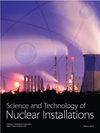Analysis of Heat Release Processes inside Storage Facilities Containing Irradiated Nuclear Graphite
IF 0.9
4区 工程技术
Q3 NUCLEAR SCIENCE & TECHNOLOGY
引用次数: 0
Abstract
The article is dedicated to the safety assessment of mixed storage of irradiated graphite and other types of radioactive waste accumulated during the operation of uranium-graphite reactors. The analysis of heat release processes inside storages containing irradiated nuclear graphite, representing a potential hazard due to the possible heating and, accordingly, the release of long-lived radionuclides during oxidation was carried out. The following factors were considered as the main factors that can lead to an increase in the temperature inside the storage facility: corrosion of metallic radioactive waste, the presence of fuel fragments, and also the random exposure of irradiated graphite to local sources of thermal energy (spark, etc.). It was noted in the work that the combined or separate influence of some factors can lead to an increase in the temperature of the onset of the initiation of Wigner energy release in graphite radwaste (Tin ≈ 90–100°C for the “Worst-case” graphite). The model of heat generation in the storage was developed based on the analysis of the features of graphite radioactive waste storage and Wigner energy release. The layered location of different types of waste (graphite and aluminum) and the local character of the distribution of heat sources were adopted in this model. The greatest heating is achieved if graphite radioactive waste is located near the concrete walls of the storage facility, as well as in direct contact with irradiated aluminum radioactive waste, which was shown in this paper.辐照核石墨贮存设施内部放热过程分析
本文致力于对铀-石墨反应堆运行过程中积累的辐照石墨和其他类型放射性废物的混合储存进行安全评估。对含有辐照核石墨的仓库内的热释放过程进行了分析,这代表了由于可能的加热而产生的潜在危险,因此,在氧化过程中释放了长寿命放射性核素。以下因素被认为是可能导致储存设施内温度升高的主要因素:金属放射性废物的腐蚀、燃料碎片的存在、,以及辐照石墨随机暴露于局部热能源(火花等)。工作中注意到,一些因素的组合或单独影响会导致石墨放射性废物中Wigner能量释放起始温度的升高(Tin ≈ 90–100°C(对于“最坏情况”的石墨)。在分析石墨放射性废物贮存和Wigner能量释放特征的基础上,建立了贮存过程中的热量产生模型。该模型采用了不同类型废物(石墨和铝)的分层位置和热源分布的局部特征。如本文所示,如果石墨放射性废物位于储存设施的混凝土墙附近,并与辐照过的铝放射性废物直接接触,则可实现最大的加热。
本文章由计算机程序翻译,如有差异,请以英文原文为准。
求助全文
约1分钟内获得全文
求助全文
来源期刊

Science and Technology of Nuclear Installations
NUCLEAR SCIENCE & TECHNOLOGY-
CiteScore
2.30
自引率
9.10%
发文量
51
审稿时长
4-8 weeks
期刊介绍:
Science and Technology of Nuclear Installations is an international scientific journal that aims to make available knowledge on issues related to the nuclear industry and to promote development in the area of nuclear sciences and technologies. The endeavor associated with the establishment and the growth of the journal is expected to lend support to the renaissance of nuclear technology in the world and especially in those countries where nuclear programs have not yet been developed.
 求助内容:
求助内容: 应助结果提醒方式:
应助结果提醒方式:


